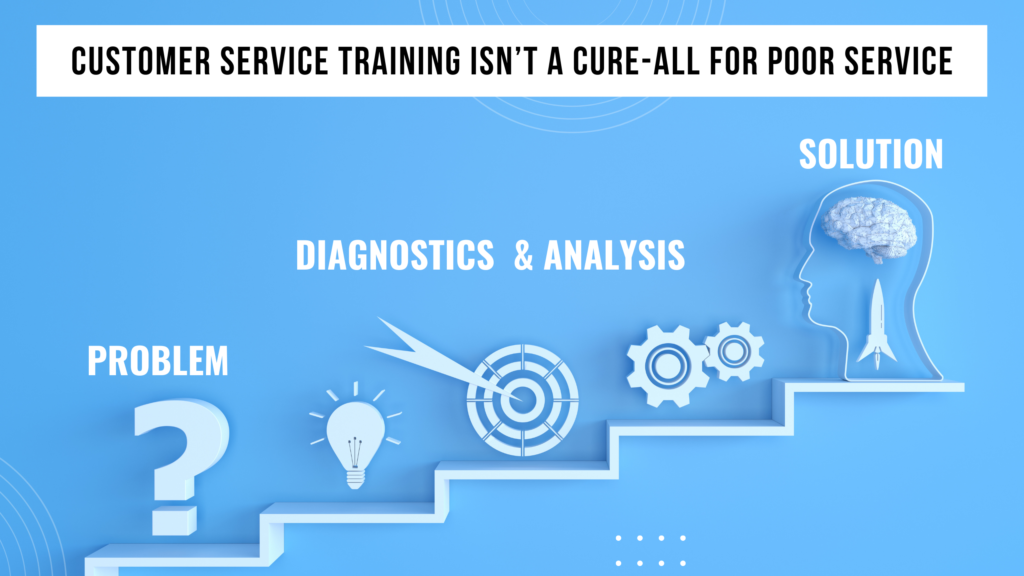Training by itself is not a cure for all of the customer experience ills present in a business. A widely-held belief amongst leaders of businesses is that if staff members are exposed to short-term training over one or two days, then customer experience ratings will surge upwards. Nothing can be further from the truth.
Now, I will say that under specific conditions, training may be the right application, especially if the majority of the staff members are customer-interfacing, if they operate as a well-oiled team and if a high level of standardization and consistency in service delivery exists.
A widely-held belief amongst leaders of businesses is that if staff members are exposed to short-term training over one or two days, then customer experience ratings will surge upwards. Nothing can be further from the truth.
When a business arrives at the conclusion that its customer experience is problematic, the next action should be to deploy a diagnostic process to determine the points of weakness. These weaknesses may point to process, technology, customer journey, internal communication, efficiency, customer engagement and \ or skill-deficiency issues. The possibility gaps are endless. What is indisputable, is that the quality of customer experience will be impacted negatively, if one or more of these weaknesses go unchecked.
My point is that diagnosis is critical. Correct diagnosis leads to the selection of the best corrective action. This may or may not revolve around customer service training. Getting the right match between problem identification and a solution prescription relies heavily on the lens of the diagnostician. It’s easy to point to training if one isn’t trained in the science of problem recognition and failure diagnostics.
When a business arrives at the conclusion that its customer experience is problematic, the next action should be to deploy a diagnostic process to determine the points of weakness.
One challenge with using training as a universal solution is the predisposition to focus on the behavioural fault line. This means that the underlying assumption is that the problem is skill-related and so, training will create a skill-fix. Some “diagnosticians” do not exercise their powers of discernment enough, when it comes to labelling the problems correctly. All of this to me, is a lazy fix and points to the need for businesses to become more fastidious when labelling customer experience issues.
Another challenge with using training as an auto-correction tool, is that if the problems were related to endemic organizational inefficiencies, at the end of the training, the inefficiencies will persist. Sometimes employees fail to keep promises that they make to the customer, e.g. not returning calls as promised. This may either be an accountability issue, an under-staffing issue, a glitch in the automated workflows, or a task management issue. Solution matching will be better served in this instance, through correct diagnosis of the problem.
Correct diagnosis leads to the selection of the best corrective action. This may or may not revolve around customer service training.
Now here’s an interesting situation. There are times when customer engagement training (the term that I prefer), is correctly positioned as the (behavioural-based) solution to the customer experience weakness. So, training happens, all goes well, employees emerge energized, armed with useful tools to be added to their toolkits and ready to practise on the customers. Well, let me share a reality here. Typically, when training ends, twenty to forty percent of the participants will need follow-on coaching to help them master the new skills. Without coaching, the risk of underdevelopment of the skill becomes real. So, in those instances when training is the correct prescription, I strongly suggest that it be paired with coaching cycles for as long as required, to enable employees to master the skills.
There’s another circumstance where training may be the correct prescription, but only after a primary action has been undertaken to support the efficacy of the training. The primary action may be the deployment of service standards, which paves the way for employees to be trained up to meet the new standards.
Another challenge with using training as an auto-correction tool, is that if the problems were related to endemic organizational inefficiencies, at the end of the training, the inefficiencies will persist.
If a business is thinking of improving its customer experience ratings, I would suggest putting a pause on the reflexive action of deploying customer service (engagement) training. A useful start would be a three sixty degree assessment of the problem, whilst applying root cause analysis. Correct diagnosis will improve the chances of matching the correct solution to the problem and therefore, bumping up the chances of a successful outcome.
Finally, let’s remember that customers are becoming used to interacting less with humans, so customer service (engagement) training has to not only be the right solution, but will need to be design-sensitive to the new rules of customer engagement.
A useful start would be a three sixty degree assessment of the problem, whilst applying root cause analysis.

